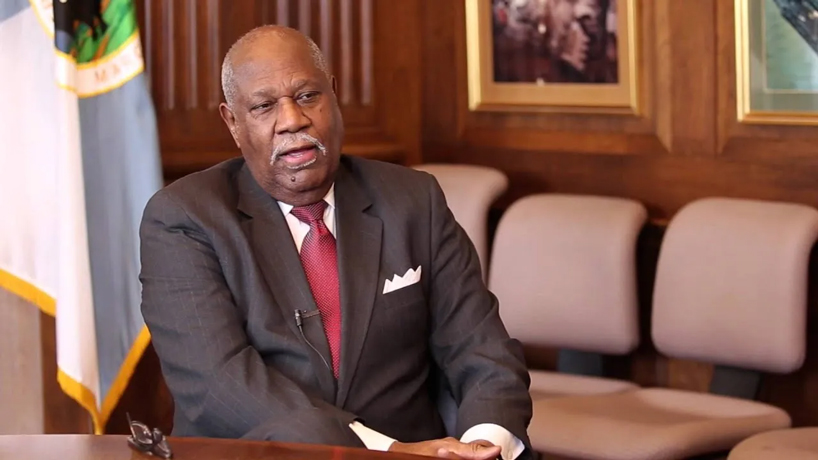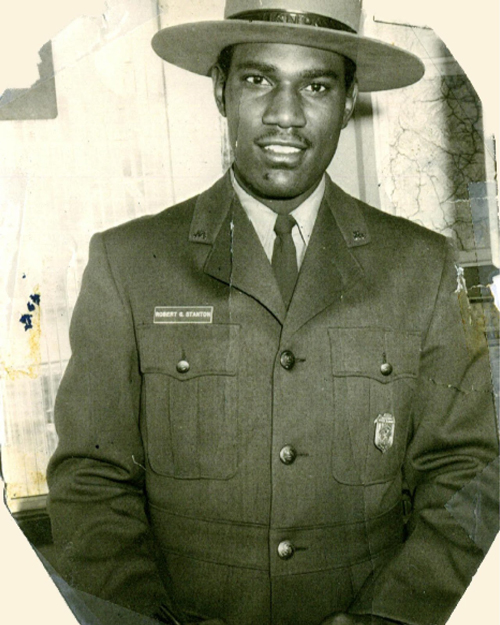
In his new role at UMSL, Robert Stanton will work with E. Desmond Lee Endowed Professor of Experiential and Family Education Theresa Coble and her third Heritage Leadership for Sustainability, Social Justice and Participatory Culture doctoral cohort. (Photo courtesy of the Department of the Interior)
In 1962, Robert Stanton left Texas for the first time on a train bound for Wyoming.
Stanton, then a junior at Huston-Tillotson College – now university – in Austin, Texas, had been recruited to serve as a seasonal park ranger at Grand Teton National Park under the auspices of then-Secretary of the Interior Stewart Udall. Stanton was part of a concerted effort by Udall to diversify the National Park Service workforce, and he became one of the first Black park rangers to work at Grand Teton.
He was awed by the snowcapped Teton Mountain Range and Jackson Lake, but the welcome he received from the senior staff during the height of the civil rights movement made a much more profound impact.
“I’ve often reflected – that’s been 60 years ago this year – that I could not have been placed in a more encouraging and more supportive environment than Grand Teton National Park in ’62,” Stanton said. “It was the caliber of the people that mentored me and guided me as a young seasonal ranger.”
That summer led to Stanton’s storied, 35-year career serving the NPS as a ranger, superintendent, deputy regional director, assistant director, associate director, and regional director of the National Capital Region. In 1997, it culminated with President Clinton naming him the 15th director of the NPS. The historic nomination made him the first Black director in the bureau’s history and the first director to be confirmed by the U.S. Senate.
Next semester, Stanton will bring his experience and expertise in historic preservation and natural resources to the University of Missouri–St. Louis College of Education.
E. Desmond Lee Endowed Professor of Experiential and Family Education Theresa Coble tapped Stanton to serve as the college’s latest scholar in residence.
In the new role, Stanton will work with Coble’s third Heritage Leadership for Sustainability, Social Justice and Participatory Culture doctoral cohort. Classwork will begin in August, and Coble expects to admit about 25 doctoral candidates.
The unique program is designed to be completed in three years and operates almost entirely online. Cohort members examine the link between natural and cultural heritage, while also grappling with the difficult topics surrounding heritage sites such as bias, ethics, oppression, privilege and trauma.
Coble said Stanton is a perfect fit for the cohort given his background with the NPS and added that working with him is a career highlight.
“I could not be more impressed or delighted with the high-power team who will be leading the next heritage leadership doctoral cohort,” said College of Education Dean Ann Taylor. “What an intellectual treat is in store for everyone involved.”
Coble concurred.
Robert Stanton began his career with the National Park Service in 1962 as seasonal ranger at Grand Teton National Park. Stanton was part of a concerted effort by then-Secretary of the Interior Stewart Udall to diversify the NPS workforce. He became one of the first Black park rangers to work at Grand Teton. (Photo courtesy of the National Park Service)
“Bob Stanton will add depth, nuance, wisdom and experience as we wrestle with high-conflict topic areas in our classes,” she said. “He’ll help us develop skills; he’ll help us gain perspectives that we couldn’t get any other way.”
Bill Gwaltney, former assistant regional director of the NPS Intermountain Region and longtime friend and colleague of Stanton, helped facilitate the new partnership. Gwaltney worked with Coble’s previous cohorts on a volunteer basis, aiding students and enriching their experience in the program. In December, he arranged for Stanton to be a guest speaker, which then evolved into a discussion about a more long-term, official association with the program.
“We were all just enthralled to have Bob Stanton in our midst, to have a chance to hear what he had to say,” Coble said. “He’s so relatable, so personable, and his life story is unbelievable.”
Stanton was interested in pursuing the scholar in residence position because he felt the EdD program aligns closely with his work at the NPS and as a member of the Advisory Council on Historic Preservation, an independent federal agency.
“The subject matter itself has a lot of interest to me, and it’s something I’ve been engaged with for a long period of time,” Stanton said. “Then I was really inspired by Dr. Coble and her passion – tremendous passion and energy. I had an opportunity to interact virtually with several of the participants in the program when I was the guest speaker, and that inspired me. I felt that I would be privileged to have the opportunity to be a part of the program.”
Stanton noted each of the 424 units of the National Park System has unique values and lessons to impart to the public, particularly those that speak to some of the painful periods in the country’s history.
“In terms of giving me strength, giving me a place for encouragement, two are located in the nation’s capital,” Stanton said. “One is a memorial to Dr. Mary McLeod Bethune, a courageous leader, government administrator and educator. It was the first memorial, not only to a Black woman, but the only memorial in the nation’s capital that was constructed on national park lands to any woman.
“The other is certainly my all-time hero, and I’ve often said that he and I met at the National Park Service in the same year. I donned for the first time the NPS green and gray uniform in June of ’62, and on Sept. 5, President John F. Kennedy signed a bill into public law authorizing the home of Frederick Douglass as a unit of the National Park System. His spirit burns deeply within me.”
Drawing upon that spirit, Stanton worked diligently to increase the diversity of the bureau’s staff and public programs to better serve minority populations. He pointed out that all Americans are entitled to understand, enjoy and contribute to national parks, even though that message has not always been emphasized.
“I feel very strongly that the National Park Service workforce and programs should represent the face of America,” he said.
Such conversations about representation and unvarnished history are central to the program’s mission. Coble is confident that Stanton is singularly qualified to guide the doctoral students through those discussions.
“He uses the lens of the historic preservation community – the legal requirements of historic preservation – but he’s also interested in how we tell the stories and how the sites are used to help people understand our past in ways that are holistic,” Coble said.
Stanton is honored to be a part of the program and is excited to get to work.
“I feel that I have an obligation to give back and, more importantly, to encourage young people to look at heritage preservation in its broadest context as a way to carve their own career paths and make their own contributions,” he said. “I’m encouraged by the work that the cohort is involved in, and I’m honored and privileged to be a part of this.”















